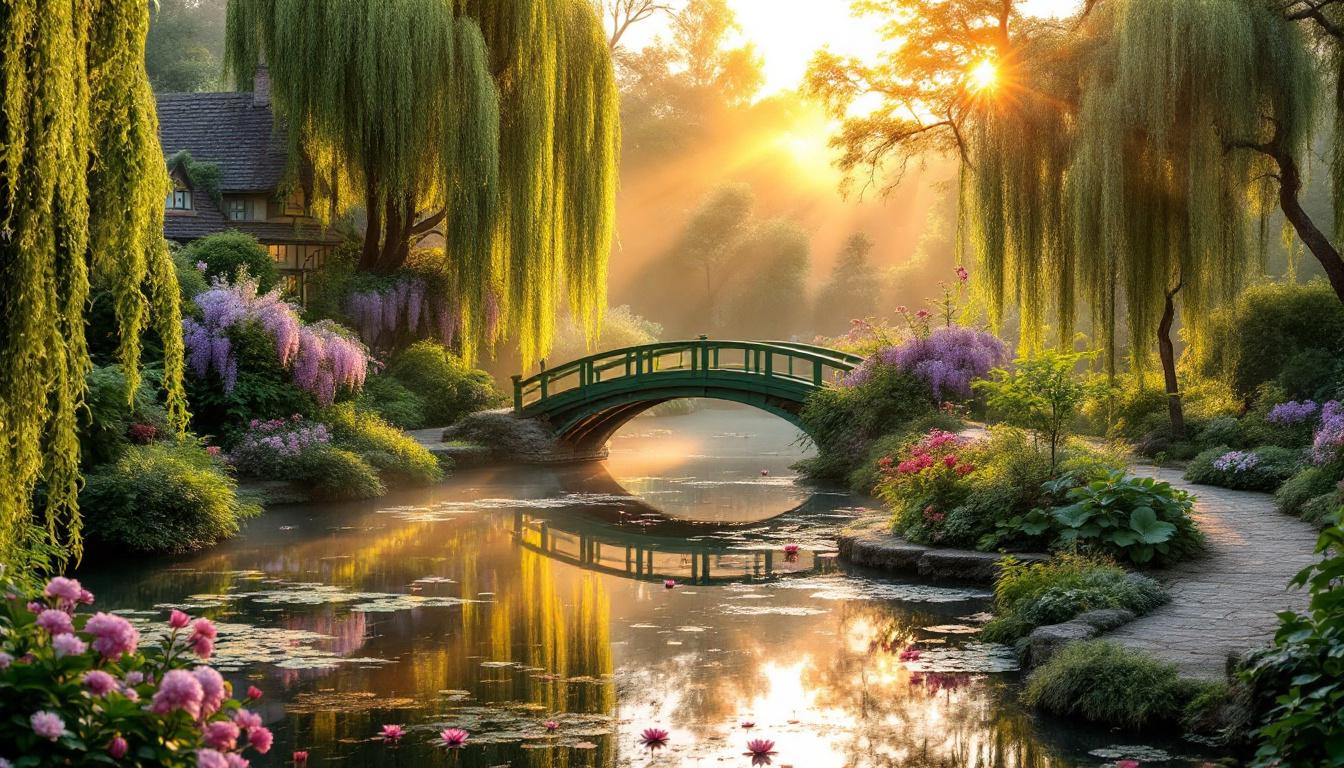In 1883, a passing glance from a train window forever changed the course of art history. Claude Monet, catching sight of a charming Norman village, decided to make it his home for the next 43 years. Today, Giverny attracts over 500,000 visitors annually to witness the living canvas that inspired Impressionism’s master. This pocket-sized paradise in Normandy’s Eure department offers far more than just famous water lilies.
The gardens that launched a thousand paintings
Monet’s gardens aren’t merely pretty flora arrangements—they’re deliberate artistic compositions. The painter designed his water garden with the Japanese bridge and lily pond specifically to create scenes he could paint repeatedly under different light conditions. Walking these paths feels like stepping directly into his canvases, especially during morning hours when soft light bathes the famous Japanese bridge.
“I perhaps owe becoming a painter to flowers,” Monet once confessed, and nowhere is this connection more evident than in Giverny’s living masterpiece.
Beyond the water lilies: Giverny’s secret corners
While crowds flock to the famous pond, savvy travelers explore the Clos Normand flower garden where vibrant borders create what locals call “a painter’s paradise.” The flower arrangements change seasonally, making spring visits dramatically different from autumn ones. Don’t miss Monet’s vegetable garden, often overlooked but equally charming with its geometric layouts and heritage produce varieties.
The village church, Église Sainte-Radegonde, houses Monet’s family tomb alongside British airmen who fell during D-Day operations—an unexpected historical layer beneath the artistic veneer. Like France’s hidden medieval treasures, Giverny rewards those who venture beyond the obvious.
Ride through an impressionist landscape
The abandoned railway path connecting Vernon to Giverny, now transformed into the Voie André Touflet, offers cyclists an immersive journey through landscapes straight from Monet’s palette. Rent a vintage-style bicycle in Vernon and pedal the 5km route alongside the Seine, passing fields of sunflowers that rival even the most spectacular natural wonders.
“The Seine Valley light changes by the minute—it’s why artists never tire of this landscape,” explains Marie Dumont, a local tour guide who leads bicycle excursions through the area.
A museum that completes the picture
The Musée des Impressionnismes provides crucial context to Monet’s work, exploring how Giverny became an artist colony that attracted American painters like Mary Cassatt. Its contemporary architecture and sculpture garden create a thought-provoking contrast to the historical gardens nearby. The museum’s changing exhibitions mean even return visitors discover something new.
Float above a painter’s paradise
For a truly unforgettable perspective, hot air balloon rides offer aerial views of Giverny and the Seine Valley. These dawn flights reveal the patchwork landscape that inspired countless paintings, with the morning mist creating atmospheric conditions reminiscent of Monet’s famous series works. Like other elevated natural wonders, seeing Giverny from above offers an entirely new appreciation.
Where to stay and dine
Le Jardin des Plumes, a Michelin-starred restaurant with rooms, occupies a charming Norman building where the culinary creations are as artistic as the surroundings. For more modest budgets, the village cafés along Rue Claude Monet serve rustic Norman fare featuring local cheeses and ciders. Vernon, just 5km away, offers additional accommodation options and surprisingly wild natural settings along its riverbanks.
Timing your visit to perfection
The gardens open from April 1st to November 1st, with May offering spectacular blooms without peak summer crowds. October provides a different magic—the autumn colors transform the water garden into a symphony of reds and golds that mirror nature’s most dramatic displays. Early mornings let you photograph the gardens in the same light that captivated Monet.
Giverny isn’t just a place to see—it’s a place to feel. Standing where Monet stood, watching light dance across water lilies, you’ll understand why a simple train journey led to artistic revolution. In this corner of Normandy, beauty isn’t just observed; it’s experienced with every sense, just as the master intended.
